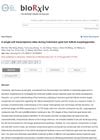Search
for
Did you mean single-cell transcriptomics?
Learn
5 / 8 resultslearn Osteopontin
signaling protein that, when suppressed, may grow hair by reducing inflammation and stem cell loss
learn Epidermal Growth Factor
learn Follistatin
glycoprotein that inhibits TGF-β and promotes hair growth by antagonizing activin
learn Thymosin Beta 4
Research
5 / 1000+ resultsresearch Single-Cell Transcriptome Sequence Profiling on the Morphogenesis of Secondary Hair Follicles in Ordos Fine-Wool Sheep
The research identifies genes linked to wool quality in sheep and provides insights to improve wool production.

research A Single-Cell Transcriptome Atlas During Cashmere Goat Hair Follicle Morphogenesis
The research mapped out the cell types and molecular processes involved in developing Cashmere goat hair follicles.

research Single Cell Transcriptome Profiling of Human Interfollicular Epidermis Reveals Robust Heterogeneity and Divergent Differentiation Lineages
The human skin's outer layer has more variety in cell types and development paths than previously thought.
research Single Cell Analysis of Transcriptome and Open Chromatin Reveals the Dynamics of Hair Follicle Stem Cell Aging
Hair follicle stem cells change states with age, affecting hair growth and aging.
research High-Resolution Single Cell Transcriptome Analysis of Zebrafish Sensory Hair Cell Regeneration
Zebrafish regenerate sensory hair cells through three phases, offering insights for potential mammal applications.
Community Join
5 / 1000+ resultscommunity UPDATE: The theory that explains everything. Please help me make this big!
Hair loss theory involves 3alpha-hydroxysteroid reductase (3AHD) converting DHT to androstenol. Discussion explores potential treatments and encourages more research.
community Polydopamine Synergizes with Quercetin Nanosystem to Reshape the Perifollicular Microenvironment for Accelerating Hair Regrowth in Androgenetic Alopecia.
A quercetin-encapsulated and polydopamine-integrated nanosystem (PDA@QLipo) shows promise for treating androgenetic alopecia by reshaping the perifollicular microenvironment, outperforming minoxidil in hair regeneration. The nanosystem promotes cell proliferation, hair follicle renewal, and recovery by scavenging reactive oxygen species and enhancing neovascularity.
community Scientists May Have Accidentally Found a Way to Reverse Hair Loss Without Drugs
2-deoxy-D-ribose is being explored as a hair loss treatment but is not proven effective in humans and may be costly and inconvenient. Minoxidil remains the most effective treatment.

community Compressed part of research of theory of androgenic/anabolitic balance. AGA h-responders analytic. Theory of physio-metabolitic method of anti AGA treatment
The treatment for androgenetic alopecia involves using finasteride and minoxidil with intense exercise and cold exposure to boost metabolism and reduce androgenic effects, potentially leading to hair regrowth. This approach may activate biological pathways for improved hair and overall health.
community 8 years of hair loss, turning 30 next month
The user has been dealing with hair loss for 10 years, worsened by psoriasis, and uses minoxidil and finasteride. They seek advice on managing psoriasis and hair loss, with suggestions to see a dermatologist, try different shampoos, and be patient.